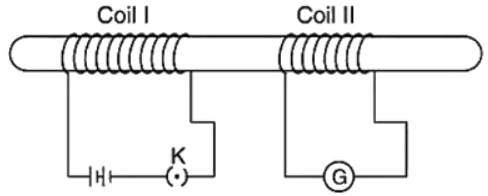Class 10 Science Chapter 12 Case Based Questions - Magnetic Effects of Electric Current
| Table of contents |

|
| Case study - 1 |

|
| Case study - 2 |

|
| Case study - 3 |

|
| Case Study – 4 |

|
| Case Study – 5 |

|
| Case Study – 6 |

|
Case study - 1
The domestic electric circuit consist of red insulated cover called as live wire, wire with black insulation called as neutral wire and the wire with green insulation is called as Earth wire. We know that fuse is connected in series with the circuit to prevent the damaging of electrical appliances and circuit from overloading. Overloading occurs when live wire and the neutral wire comes in direct contact with each other. Because of which current through the circuit increases suddenly. Also, overloading may occurs because of connecting many appliances to a single socket. The Earth wire which is green in colour is connected to a metal plate deep in the earth near the house. This type of safety measure is used in appliances like electric press, toaster, table fan, refrigerator etc. The Earth wire is gives low resistance conducting path for the electric current. In this way it protects us from severe electric shock.
All the appliances are connected in parallel circuit so that the potential difference across each appliance will be same.
Q1: What are the signs of live wire and neutral wire?
Ans: The red insulated wire is the live wire or positive and the black insulated wire is the neutral wire or negative.
Q2: In our country what is the potential difference between live wire and neutral wire?
Ans: In our country the potential difference between live wire and neutral wire is 220 V.
Q3: What is short circuiting?
Ans: When live wire and neutral wire comes in direct contact, in that situation the current through the circuit increases suddenly and it is called as short circuiting.
Q4: What is the main purpose of using fuse in electric circuit?
Ans: Because of Joule’s heating effect the heat produced causes the fuse to melt and to break the circuit. And thereby protect the circuit and electric appliances.
Case study - 2
If we stretched the thumb, forefinger and middle finger of our left hand so that they are mutually perpendicular to each other. If the forefinger gives the direction of magnetic field and middle finger gives the direction of electric current then the thumb gives the direction of motion or the force acting on the conductor.
Electric motor is used to convert electric energy into mechanical energy. It is mostly used in electric fans, refrigerators, mixers, washing machine, computers etc.
The commercial motor uses an electromagnet in place of permanent magnet, large number of turns of the conducting wire in the current carrying coil, a soft iron core on which the coil is wound. If we stretched the thumb, forefinger and middle finger of right hand so that they are mutually perpendicular to each other. If the forefinger gives the direction of magnetic field and thumb gives the direction of motion of conductor then the middle finger gives the direction of induced current. And this rule is called as Fleming’s right hand rule.
Electric generator is used to convert mechanical energy into electrical energy.The direct current always flows in one direction while the alternating current changes its direction periodically. The frequency of AC in India is 50 Hz.
Q1: Which is the important advantage of AC over DC?
Ans: The important advantage of AC over DC is that electric power can be transmitted over long distances without more loss of energy.
Q2: Electric generator works on the phenomenon of?
Ans: Electric generator is based on the phenomenon of electromagnetic induction.
Q3: Fleming’s right hand rule is used for?
Ans: Fleming’s right hand rule is used to find the direction of induced current.
Q4: The phenomenon of electromagnetic induction was discovered by?
Ans: The phenomenon of electromagnetic induction was discovered by Michael Faraday.
Case study - 3
The change in electric current through the circuit produces magnetic field around it. Magnetic field is a vector quantity which has both magnitude as well as direction. The magnetic field lines produced are directed from north pole and ends at south pole. These lines are closed curves from which strength of the magnetic field is determined. Where magnetic field lines are crowded magnetic field is stronger and where very apart the strength of magnetic field is weak. So, we can say that as the current through the electrical circuit increase then the magnitude of magnetic field also increases. If a current carrying conductor is holded in right hand by curling figures around it. Then, the curled figures gives the direction of electric current and curled figures gives the direction of magnetic field.
As the magnitude of magnetic field depends on the current through it. Also, if the number of turns of wire in a circuit is more then also the magnitude of magnetic field is more. If a coil having many circular turns of insulated copper wire wound closely to form a cylindrical shape is called as solenoid. Solenoid is used to produce strong magnetic field which can be used to magnetise the piece of magnetic material. And hence they are used in making electromagnet mainly.
Q1: What is the nature of magnetic field lines inside the solenoid?
Ans: Inside the solenoid the magnetic field lines are parallel straight lines and the magnetic field inside the solenoid is uniform.
Q2: For what right hand thumb rule is used?
Ans: The right hand thumb rule is used to find the direction of electric current which given by the thumb.
Q3: What are the properties of magnetic poles?
Ans: The like poles of a magnet repels each other and the unlike poles of magnet attract each other.
Case Study – 4
It is well known that “magnetic field is caused by electric current. ”Whenever there is a change in magnetic flux linked with a coil (or circuit) an emf is induced in the coil. This phenomenon is called electromagnetic induction. The emf produced in the coil is called the induced emf. If the coil is closed, the current thus produced is called as induced current. The direction of induced current is determining by Fleming’s right hand rule.
These induced current are used in a moving coil microphone, tape-recorders, video recorders, hard-discs in computers etc.
Based on the above information, answer the following questions
Q1: State Faraday’s law of electromagnetic induction.
Ans: When we linked magnetic field lines with a coil due to relative motion of a magent and the coil, then an induced current produced in the coil. The magnet of induced current is directly proportional. The rate of change of number of magnetic field lines to the coil.
Q2: State any two methods of inducing current in a coil.
Ans: Current can be induced in a coil by
- Rotating a coil within a magnetic field.
- Moving a coil towards or away from a magnet
- Moving a magnet towards or away from the coil
Case Study – 5
Andre Marie Ampere suggested that a magnet must exert an equal and opposite force on a current carrying conductor, which was experimentally found to be true. But we know that current is due to charges in motion. Thus, it is clear that a charge moving in a magnetic field experience a force, except when it is moving in a direction parallel to it. If the direction of motion is perpendicular to the direction of magnetic field, the magnitude of force experienced depends on the charge, velocity (v) , strength of magnetic field(B), and sine of the angle between v and B.
Q1: Direction of magnetic force is given by which rule?
Ans: Fleming’s left hand rule.
Q2: Write the statement of the rule?
Ans: It states that if we stretch thumb, forefinger or the index finger and the middle finger in such a way that they are mutually perpendicular to each other then the thumb gives the direction of the motion or the force acting on conductor, index finger gives the direction of magnetic field and the middle finger gives the direction of current.
Case Study – 6
Two coils C1 and C2 are wrapped around a non-conducting cylinder. Coil C1 is connected to a battery and key and C2 with galvanometer G. On pressing the key (K), current starts flowing in the coil C1.

State your observation in the galvanometer.
Q1: When key K is pressed on.
Ans: The galvanometer needle deflects momentarily in one direction.
Q2: When current in the coil C1 is switched off.
Ans: The galvanometer needle deflects again momentarily but in opposite direction to that in the previous case.
Q3: When the current is passed continuously through coil C1.
Ans: No deflection.
(d) Name and state the phenomenon responsible for the above observation.
Ans: Electromagnetic induction.
Explanation: Electromagnetic induction is a process by changing a magnetic field in a conductor, which induces a current in another conductor placed in nearby.
|
209 docs|44 tests
|



















